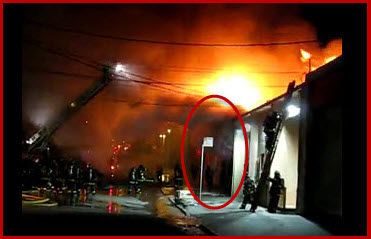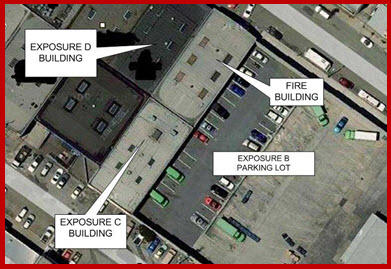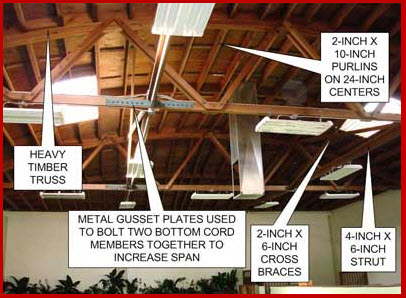Collapse of Bowstring Truss Roof Seriously Injures Fire Fighter
By Christopher J. Naum, SFPE on Dec 19, 2010 with Comments 0

Fire suppression operations on Alpha side prior to collapse. Firefighter is seen in the immediate collapse zone
The NIOSH Fire fighter Investigation and Prevention Program, Fire Fighter Fatality Investigation Reports recently released Report # F2009-12 for a Near-Miss event that seriously injured a firefighter wih significant learnings; HERE
Through the Fire Fighter Fatality Investigation and Prevention Program, NIOSH conducts investigations of fire fighter line-of-duty deaths to formulate recommendations for preventing future deaths and injuries. The program does not seek to determine fault or place blame on fire departments or individual fire fighters, but to learn from these tragic events and prevent future similar events.
On May 21, 2009, a 36-year-old male career fire fighter was seriously injured while operating in a non-designated collapse zone of a commercial structure when an overhang of a bowstring truss roof system collapsed and struck him. The first arriving company officer reported a working fire in a single story Type II warehouse.
The officer looked under a steel roll-up door that was raised approximately three feet off of the ground and saw heavy fire towards the rear of the structure from floor to ceiling. Per department procedures, the first arriving companies went into a “Fast Attack” mode. Crews attempted but were unable to enter the structure because the steel roll-up door wasn’t functioning and the man door was heavily secured.
The department’s Deputy Chief arrived on the scene 9 minutes after the initial crew and determined that the fire should be fought defensively, however, this command was not relayed over the radio or verified with all crews. A crew was operating a 2 ½-inch handline just outside the structure approximately 20 minutes after the first apparatus arrived when the overhang collapsed and trapped the nozzleman.
Key contributing factors identified in this investigation include:
- scene management and risk analysis,
- a well-involved fire in a structure with hazardous construction features, and
- fire fighters operating within a potential collapse area.
STRUCTURE
The building was constructed in 1954 and was a single-story warehouse of Type IV construction. The dimensions of the building were 110 feet deep by 50 feet wide, covering approximately 5,500 square feet. The height of the building was approximately 20 feet. The occupancy use of the building was commercial and it operated as a warehouse. The building’s structural system consisted of masonry block bearing walls with four heavy timber wood bowstring trusses for a roof system.
The heavy timber wood trusses had a 50-foot clear span to the bearing walls and were located 19 feet 9 inches on center. The heavy timber wood truss assemblies were 48 feet 7 inches in depth and were constructed of 4-inch x 6-inch timber cords and webs connected with bolt fasteners with a metal splice plate and bolt configuration at the bottom chord span. Solid 2-inch x 10-inch wood purlins located on 24-inch centering spanned perpendicular to the truss assembly with a ¾-inch plywood roofing deck. The roofing system assembly was exposed and did not have a membrane or other passive fire protection features.
Structural stability to the heavy timber truss units was provided by 2-inch x 6-inch wood cross bracing in conjunction with the stability provided by the wood purlins and plywood deck roofing membrane. The structure contained six skylights that were 3 feet by 6 feet . The overall integrity and structural stability of this type of structural support and roofing system is contingent upon all components maintaining their connections and load bearing or load transferring capacity.
The A-side was a non-load bearing wall that showed the traditional arched roof profile that is consistent with bowstring roof construction. The A-side wall also consisted of what appeared to be an overhanging or cantilevered façade that was covered by stucco. The overhang was part of the original construction that tied back into the bowstring truss system. The fire building was integrated into a block of commercial occupancies so that only the A-side was accessible for interior fire fighting activities.
The B-side exposure of the building was adjacent to a parking lot and was of masonry construction without any windows or doors. The C-side and D-side exposures were of similar size and construction and shared party walls between their respective sides. A pre-plan had not been completed for this structure.
TRAINING and EXPERIENCE
The state requires all career fire fighters to complete training equivalent to NFPA, 1001 Standard for Fire Fighter Professional Qualifications, Fire Fighter 1. The department provides up to 17 months of training to certify fire fighters to NFPA Fire Fighter 1 and 2 qualifications, and a one year probationary period of supervised training for department fire fighter certification. The additional training during this probationary time focuses on driver training, pump operations, aerial ladder operations, and specialized equipment training.
Injured Fire Fighter
The injured fire fighter had more than six years of experience and had completed department provided classroom/field training on topics such as: live fire training, rapid intervention crew (RIC) procedures, and hazardous materials.
Initial Incident Commander (IC)
The first due company officer had more than 15 years of experience with the department. Six of those years were as a fire fighter, seven years as a cross-trained paramedic, and 18 months as a lieutenant in an acting and permanent appointment at the time of the incident. The initial IC had completed the department provided five four-day sessions on critical fireground topics that were required for newly appointed lieutenants. This training included the following topics: building construction, incident management system (IMS), size-up, company operations, and rapid intervention company (RIC) operations.
Incident Commander (IC)
The IC had more than 30 years of experience and had completed department provided classroom/field training in topics such as: health and safety 1, 2, 3 & 4; fire command; fire instructor; fire investigation; fire management; fire officer; fire prevention; incident command; incident safety officer; and RIC procedures.
Incident Safety Officer (ISO)
The battalion chief who was assigned as the ISO for this incident had more than 20 years of experience and had completed department provided classroom/field training in topics such as: health and safety 1,2,3,and 4; fire command; fire instructor; RIC procedures; hazardous materials; heavy rescue 1 and 2; training officer development; wildland training; and emergency vehicle operations.
INVESTIGATION INSIGHTS
At 0446 hours central dispatch received an alarm for a reported structure fire with fire and smoke showing at a commercial occupancy. Engine 42 (E42) was the first apparatus on the scene at 0449 hours and the officer reported on the radio a working fire in a single story Type II warehouse. Note: The classification of Type II was incorrect. This building was a Type IV construction due to the heavy timber bowstring trusses.
The E42 Lieutenant and a fire fighter ran to a steel garage roll-up door that was raised approximately three feet off of the ground on the left of the A-side wall. The E42 Lieutenant looked under the door and saw heavy fire towards the rear of the structure from floor to ceiling. The E42 Lieutenant and the fire fighter attempted to raise the door but could not due to the door being dislodged from its track. Note: The door frame had been compromised by the fire and the tracks were not attached to the wall. They immediately went to a man door to the right of the A-side. It was locked and had heavy security bars. The E42 Lieutenant called Battalion Chief 6 for a truck company to perform forcible entry.
The E42 Lieutenant ordered the crew to prepare the multiversal, which is a master stream appliance that can be used on the ground, and 2 ½-inch handlines to attempt to attack the fire through the roll-up door. Note: Per department policy, all first arriving companies and officers go to work in a “fast attack” mode. At approximately 0452 hours Engine 32 (E32) and Engine 17 (E17) pulled onto the road leading to the structure within a block from the structure.
Both the E32 and E17 officers immediately radioed dispatch and requested a second alarm due to the heavy fire self-venting from the roof of the structure. E32 proceeded to the front of the structure, dropped off two 3-inch supply lines for E42, and went to hook up to a hydrant to supply E42. E32 used a 10-foot section of 3-inch supply line to hook up to one side of the hydrant. They used another 50-foot section of 3-inch supply line to hook up to the other side of the hydrant.
During this same time, at approximately 0452 hours, BC6 arrived on the scene, called to ensure a second alarm, and conducted a size-up of the front of the building and the operations taking place. A division chief arrived on the scene at 0453 hours, assumed incident command (IC), and ordered BC6 to protect Exposure D. The E17 officer and fire fighters [including the injured fire fighter (IFF)] walked up to the front of the structure and saw the E42 and E32 crews attempting to deploy the multiversal and two 2 ½-inch handlines off of E42. Note: The crews were having difficulty due to having to assemble the three 50-foot sections of 2 ½-handlines from a bag stored on top of each apparatus. The crew also removed the multiversal from on top of E42 and placed it on the ground for operation.
The IFF took the nozzle of one of the 2 ½-inch handlines and was backed up by an E17 fire fighter. Two additional fire fighters manned the other 2 ½-inch handline and were protecting the D-exposure by shooting water onto the roof from over 20 feet away from the structure. The E17 officer and E17 fire fighter operated the multiversal over 20 feet back from the roll-up door and attempted to shoot water through the opening where the door had pulled away from the wall. The E17 officer noticed that both handlines were ineffective and he went to check on the IFF. The IFF’s handline stream was ricocheting off of the man door and the four windows above it.
The L7 crew had assembled handtools on the ground in front of the Command Post. The E17 officer took a saw to the man door in an attempt to open it so that the handline could be effective. He quickly determined that the saw would not work due to the door being so heavily protected. Battalion Chief 09 arrived on the scene at 0500 hours and was designated by the IC as the Incident Safety Officer (ISO) at approximately 0504 hours. He instructed the E17 officer to attempt to open the door with a rabbit tool; the E17 officer informed the ISO he wasn’t sure where the truck company kept it. Immediately after, BC6 ordered the E17 officer to take his saw to the roll-up door and cut an opening for access.
He cut a three foot by six foot hole in the door and was attempting to cut across the door when he was tapped on the shoulder by the Deputy Chief which he assumed meant he was to quit. During this time, BC6 had received orders from the Deputy Chief to pull everyone back from the front of the building and to ensure that no one went inside. Note: According to interviews conducted by NIOSH investigators, this is the first time that anyone on the scene communicated the need to go defensive to the initial arriving officers. It was reported to the NIOSH investigators that every officer who reported to the command post was given face-to-face directions that the fire was defensive and that no one was to enter the building. This tactical decision was not relayed over the radio.
BC6 ordered the crews from E42 and E17 to set up and direct a master stream into the hole through the roll-up door from a distance. The crews fought fire from a distance with the master stream for several minutes. The IFF and the E17 fire fighter continued to fight fire with the handline moving from the roll-up door to the man door several times. Note: This crew, along with many other members that were interviewed, reported not receiving any orders regarding a defensive operation.
BC6 noticed that the fire had compromised an electrical weather head and that the power lines were going to come down soon. He turned to order crews to vacate the area where the power lines would possibly fall when he heard a large crash. He turned back and saw that the roof overhang had fallen onto the sidewalk. The collapse trapped the IFF who was operating the handline into the windows along with the E17 fire fighter. Members immediately rushed to the scene to rescue the trapped fire fighter.
- The IC ordered BC6 to command the rescue crew and complete a personnel accountability report (PAR) for the fireground.
- A full PAR was completed and the trapped fire fighter was removed and transported to a local hospital.
NIOSH investigators concluded that, to minimize the risk of similar occurrences, fire departments should:
- ensure that they have consistent policies and training on an incident management system
- develop, implement and enforce written standard operating procedures (SOPs) that identify incident management training standards and requirements for members expected to serve in command roles
- ensure that the incident commander conducts an initial size-up and risk assessment of the incident scene before beginning fire fighting operations
- ensure that the first due company officer establishes a stationary command post, maintains the role of director of fireground operations, and does not become involved in firefighting efforts
- implement and enforce written standard operating procedures (SOPs) that define a defensive strategy
- ensure that policies are followed to establish and monitor a collapse zone when conditions indicate the potential for structural collapse
- train all fire fighting personnel on building construction and the risks and hazards related to structural collapse
- conduct pre-incident planning inspections of buildings within their jurisdictions to facilitate development of safe fireground strategies and tactics
NIOSH RECOMMENDATIONS
- Recommendation #1: Fire departments should ensure that they have consistent policies and training on an incident management system.
- Recommendation #2: Fire departments should develop, implement and enforce written standard operating procedures (SOPs) that identify incident management training standards and requirements for members expected to serve in command roles
- Recommendation #3: Fire departments should ensure that the incident commander conducts an initial size-up and risk assessment of the incident scene before beginning fire fighting operations
- Recommendati on #4: Fire departments should ensure that the first due company officer establishes a stationary command post, maintains the role of director of fireground operations, and does not become involved in firefighting efforts.
- Recommendation #5: Fire departments should develop, implement and enforce written standard operating procedures that define defensive fire fighting operations.
- Recommendation #6: Fire departments should ensure that policies are followed to establish and monitor a collapse zone when conditions indicate the potential for structural collapse.
- Recommendation #7: Fire departments should train all fire fighting personnel in building construction and in the risks and hazards related to structural collapse.
- Recommendation #8: Fire departments should conduct pre-incident planning inspections of buildings within their jurisdictions to facilitate development of safe fireground strategies and tactics.
- Discussion: NFPA 1620 Standard for Pre-Incident Planning, states “The purpose of this document shall be to develop pre-incident plans to assist responding personnel in effectively managing emergencies for the protection of occupants, responding personnel, property, and the environment.” A pre-incident plan identifies deviations from normal operations and can be complex and formal, or simply a notation about a particular problem such as the presence of flammable liquids, explosive hazards, modifications to structural building components, or structural damage from a previous fire.
- Building characteristics including type (or more importantly risk) of construction, materials used, occupancy, fuel load, roof and floor design, and unusual or distinguishing characteristics should be recorded, shared with other departments who provide mutual aid, and if possible, entered into the dispatcher’s computer so that the information is readily available if an incident is reported at the noted address.
- Since many fire departments have tens and hundreds of thousands of structures within their jurisdiction, it is a challenge to establish an effective preplanning system. Priority should be given to those having elevated or unusual fire hazards and life safety considerations.
One tool for fire departments to use in assessing their risks for structures within their jurisdictions is the mnemonic, BECOME SAFE: (HERE)
- Building
- Evaluation
- Construction/occupancy
- Operational hazards
- Manage time and elements
- Engagement
- Situational awareness
- Assessment and risk analysis
- Fire behavior and effects
- Evaluate and execute
In this incident, the presence of the bowstring truss presented an elevated life safety consideration in the event of a fire. A thorough building inspection and pre-incident plan for a single-story, bowstring truss occupancy in this area could have potentially identified the hazards typically associated with this type of construction such as: ceiling voids, fuel loads, non-permitted renovations, roof construction, HVAC location, and exit locations. Evaluating the construction features and layout of the structure allows the fire department the opportunity to determine a response protocol for the specific identified hazards and to develop fireground strategies and tactics (ventilation strategies, avenues of fire spread, proper attack line selection, etc.) before an incident occurs.
-
See Report Insights related to Bowstring Truss Roof Operations on the FDNY Waldbaum’s Fire August 1978; HERE
Filed Under: Adaptive Fireground Management • BuildingsonFire • Predictive Occupancy Performance • Reading the Building




























